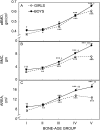Bone structure at the distal radius during adolescent growth
- PMID: 19113916
- PMCID: PMC2683647
- DOI: 10.1359/jbmr.081255
Bone structure at the distal radius during adolescent growth
Abstract
The incidence of distal forearm fractures peaks during the adolescent growth spurt, but the structural basis for this is unclear. Thus, we studied healthy 6- to 21-yr-old girls (n = 66) and boys (n = 61) using high-resolution pQCT (voxel size, 82 microm) at the distal radius. Subjects were classified into five groups by bone-age: group I (prepuberty, 6-8 yr), group II (early puberty, 9-11 yr), group III (midpuberty, 12-14 yr), group IV (late puberty, 15-17 yr), and group V (postpuberty, 18-21 yr). Compared with group I, trabecular parameters (bone volume fraction, trabecular number, and thickness) did not change in girls but increased in boys from late puberty onward. Cortical thickness and density decreased from pre- to midpuberty in girls but were unchanged in boys, before rising to higher levels at the end of puberty in both sexes. Total bone strength, assessed using microfinite element models, increased linearly across bone age groups in both sexes, with boys showing greater bone strength than girls after midpuberty. The proportion of load borne by cortical bone, and the ratio of cortical to trabecular bone volume, decreased transiently during mid- to late puberty in both sexes, with apparent cortical porosity peaking during this time. This mirrors the incidence of distal forearm fractures in prior studies. We conclude that regional deficits in cortical bone may underlie the adolescent peak in forearm fractures. Whether these deficits are more severe in children who sustain forearm fractures or persist into later life warrants further study.
Figures






References
-
- Landin LA. Fracture patterns in children. Acta Orthop Scand. 1983;54(Suppl 202):1–109. - PubMed
-
- Kramhoft M, Bodtker S. Epidemiology of distal forearm fractures in Danish children. Acta Orthop Scand. 1988;59:557–559. - PubMed
-
- Bailey DA, Wedge JH, McCulloch RG, Martin AD, Bernhardson SC. Epidemiology of fractures of the distal end of the radius in children as associated with growth. J Bone Joint Surg Am. 1989;71:1225–1231. - PubMed
-
- Tinkle BT, Wenstrup RJ. A genetic approach to fracture epidemiology in childhood. Am J Med Genet C Semin Med Genet. 2005;139:38–54. - PubMed
-
- Khosla S, Melton LJ, III, Dekutoski MB, Achenbach SJ, Oberg AL, Riggs BL. Incidence of childhood distal forearm fractures over 30 years: A population-based study. JAMA. 2003;290:1479–1485. - PubMed

